Building on the success of the EX222 amplifier EX222 (which we tested here), the French brand BC Acoustique has designed the EX712 mini stereo with the same amplification system, however with a reduced power of 2 x 40W / 8 Ω (2 x 60W / 4 Ω) (instead of 2 x 70W / 8 Ω and 2 x 120W / 4 Ω), which is nonetheless very decent.
In order to provide a device that opens up new ways of listening to music, that is to say in conjunction with audio files stored on a computer or mobile device, BC Acoustique has equipped its EX712 with a converter with two S/PDIF inputs (one coaxial and one optical) and a Bluetooth aptX receiver, so it can play files stored in CD quality on a computer or a smartphone, with sound quality very close to that of a CD.
And for those who remain attached to their silver plastic, the EX712 has an integrated CD-player.
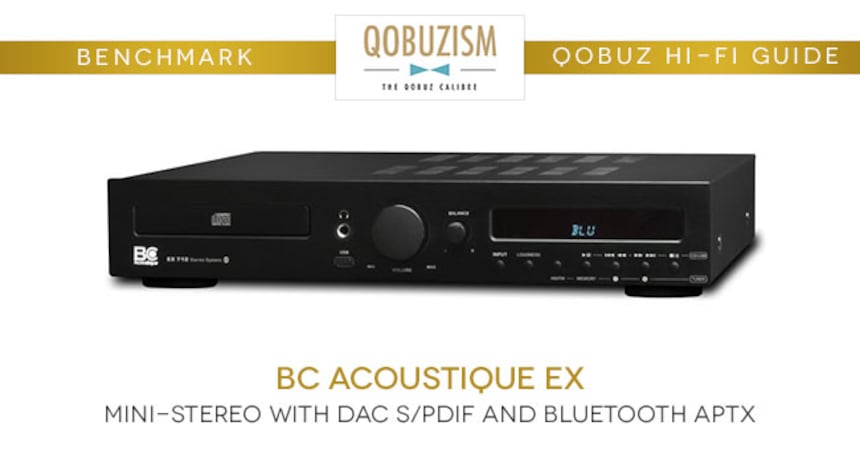
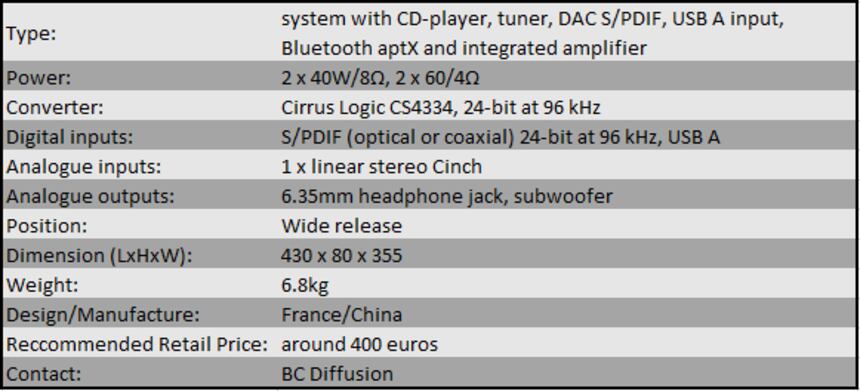
Presentation
Available only in a black finish, the EX712 compact HiFi from BC Acoustique looks much like a traditional HiFi with an aluminium facade.
The various controls, disc drawer and display are shown symmetrically on the front, in a way which is pleasant and sensible.

The volume knob is in the centre with a smaller balance control to its right, followed by the display below which is the input selector, the loudness control, AM / FM radio selection and the buttons relating to the CD player, which are also used for reading files from storage media connected to the USB A input, and three of which are also used in the tuner for its memory and searching.
The USB A socket (protected by a removable rubber stopper, a rare attention to detail which maintains the aesthetic and deserves to be mentioned) and the 6.35mm standard headphone jack are located to the left of volume knob. Finally, the CD drawer occupies the remaining space on the left side of the front face.
Connectivity
The connectivity of the EX712, broadly in line with that of a device of this type, has some (good) surprises.

There is an auxiliary stereo input, two S/PDIF inputs (coaxial and optical, but you would have to use one or the other), sockets for the tuner antennae as well as the antenna of the Bluetooth receiver, next to which is a connector for supplying an external phono card such as the EX-phono-2x.
There is also an output for subwoofer next to which a slide switch filters the signals to the main speakers by eliminating low frequencies, thus relieving smaller speakers so that they are able to more easily restore left and right filtered signals.
Finally, the speaker terminals accept bare wires such as 4mm banana plugs.
Manufacturing
Housed in a sturdy frame made of steel plates coated with baked-on black paint, the electronics of the EX712 have been made with particular care. For example, the paths of the wires are properly carried out and these are held in place and secured by clamps, while the transformer leads that pass between the radiators are protected from the heat by a cladding.
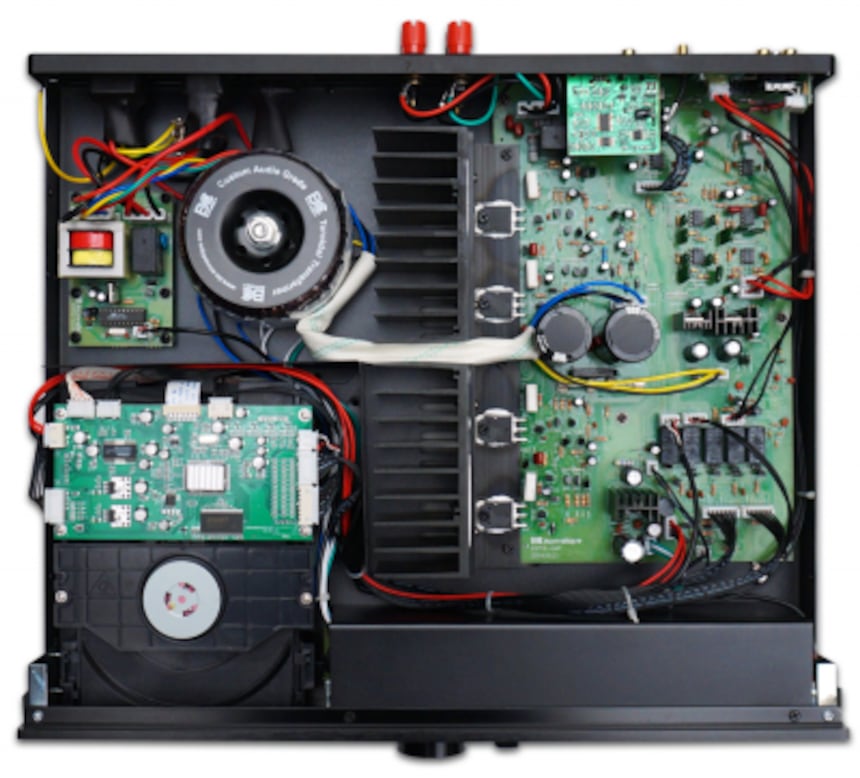
The toroidal transformer of the power supply consisting off multiple coils is manufactured to specifications and is printed not only with 'BC Acoustique' but also the indications of secondary voltages, which can be useful for a potential future maintenance.
The digital card has a Cirrus Logic CS8415 receiver (24-bit at 96 kHz) and a CS4334 digital-analogue converter (24-bit at 96 kHz), also by Cirrus Logic.
The filtering is performed by an active filter built around a TJM4558 dual operational amplifier manufactured by ST Microelectronics.
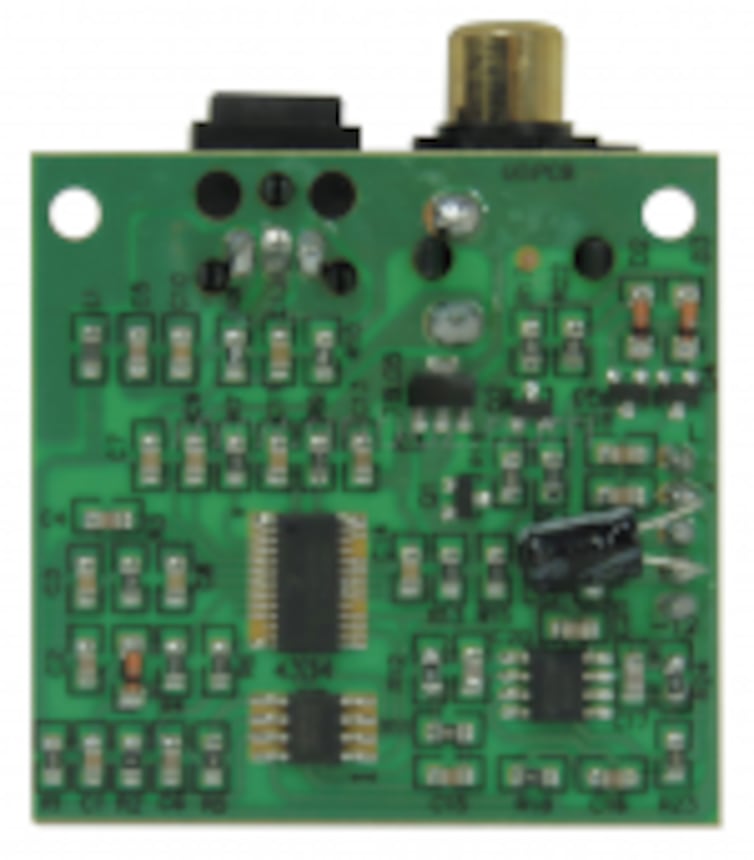
The power supply to the amplifier's power units, the filtering of which is provided by two capacitors with a respectable 10,000μF/63V, is close by in order to provide the shortest possible route for the current.
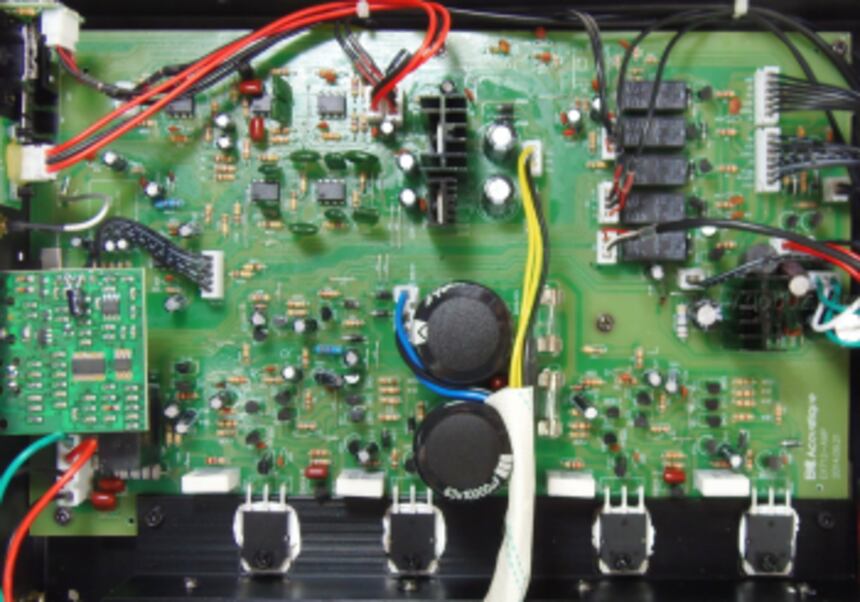
These power units are equipped with complementary Toshiba 2SA1941 and 2SC5198 transistors, each of which can support a power of 100W, so are perfectly suited to the power of this amplifier.
They are cooled by two solid aluminum cooling fins of substantial dimensions and there are, along the bracket to which the power transistors are fixed, S9014 transistors likely operating as temperature sensors to stabilise the temperature of these power transistors.
The preamp section has its own power supply made from separate coils from those of the power section, thus avoiding the effects of current draw from the latter on the preamp.
It contains 7812 (+12V) and 7912 (-12V) controllers associated with the electrochemical capacitors of 1000 μF/25V, as well as the NJM4580 operational amplifiers manufactured by JRC (New Japan Radio Company), low-noise and low-distortion models often used in audio, whilst the headphones amplifier uses the NJM4558 model by the same manufacturer.
On the card, you can also see on the switching inputs, while the motorized potentiometer is located on another small circuit along the front, which also includes the headphone jack and the relay for the loudness circuit.
The aptX Bluetooth receiver circuit is mounted on a slope and is not visible. This is a model manufactured by CSR (Cambridge Silicon Radio, inventor of the aptX) and is identical to that used on the EX222 amplifier, also by BC Acoustique.
A card mounted parallel to the facade combines the display and control buttons as well as the management microcontroller and the remote control receiver (an Atmel AT89C2051micro programmable controller) located on the standby power circuit, by which it is powered continuously, as you can see on the picture below which also shows in close-up the power transformer and the electronics of the CD player.
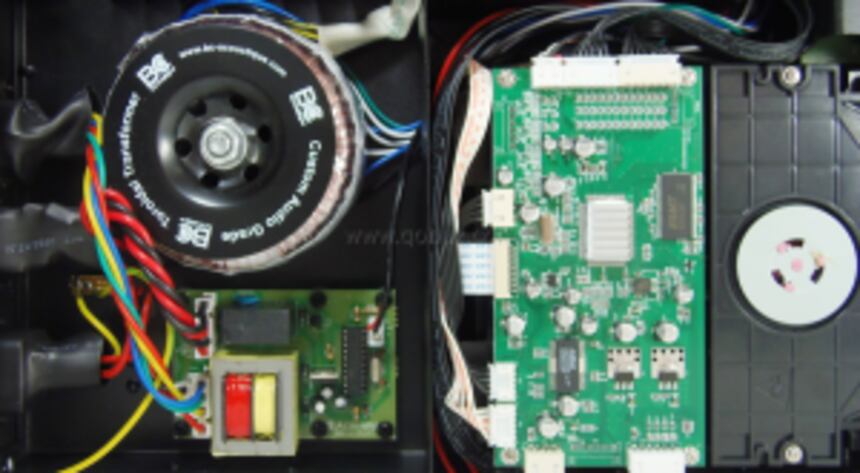
Listening
We listened to the EX712 via the S/PDIF (via a USB-S/PDIF NuForce U192 converter), and this is an amplifier that warms both the ears and the heart providing "to the letter" restitution and even more, when tested with the song Chaleur Humaine from the album of the same name by Christine and The Queens.
It glides and soothes, and the EX712 delivers not only strong bass notes but also a midrange with a certain warmth, resulting in a thorough clarity of the lyrics, and the sound increase is gentle - which seems much more preferable to a more forceful intervention that often interrupts the tonal balance.
The restitution is dense, warm and full of emotion on One from Ed Sheeran's album X. Listening is truly a pleasure with the EX712, the restitution keeping all of the track's flavour even when you up the volume, the vocals taking on a beautiful lightness. It makes you want to crank the volume right up.
The violin sings with grace and the orchestra is distilled to a beautiful soundscape when listening to Bruch's Scottish Fantasy as performed by Kyung Wha Chung on the violin with the Royal Philharmonic Orchestra conducted by Rudolf Kempe. One is swept away by this expansive and exquisite restitution which has the power to evoke intense emotion.
The bright and vivid Vespri per l'Assunzione di Maria Vergine by Vivaldi performed by Rinaldo Alessandrini directing the Concerto Italiano might not quite have all of the bite in the stabs of strings which we might expect, but the timbres are shown in their best lights and the restitution in its entirety is extensive and gratifying. There's not much to add with regards to using with the Bluetooth aptX connection; it worked just as well.
In conclusion, we really enjoyed the BC Acoustique EX712 due to its broad potential, attractive appearance, reasonable price, its professional manufacturing and of course the expansive and warm sound quality. Altogether, this list of qualities has led us to give it our Qobuzism.
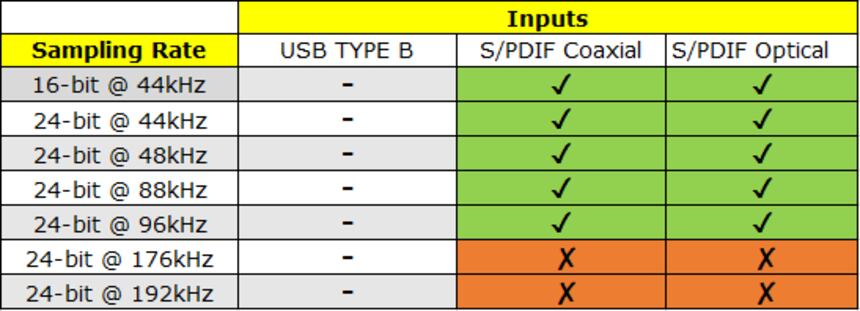
If you are a manufacturer, importer, distributor or actor in the domain of sound reproduction and you wish to contact us, please do so using the following address: newstech@qobuz.com
If you are passionate about our Hi-Fi Guide and you wish to contact us, please do so using the following address: rubriquehifi@qobuz.com
Original article by PHILIPPE DAUSSIN Translation by RACHEL HARPOLE

